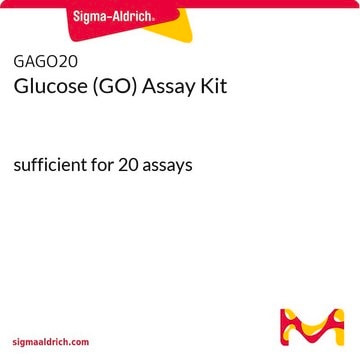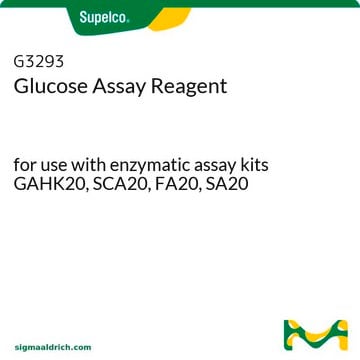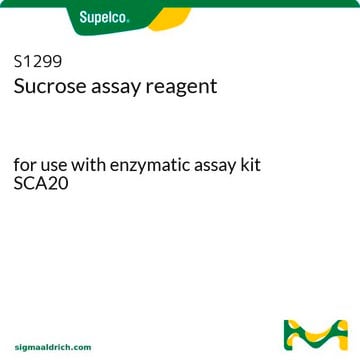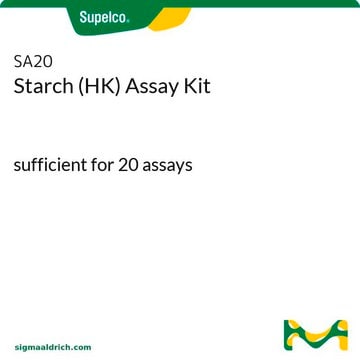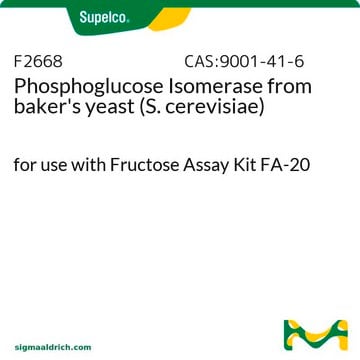Products may be shipped at a different temperature than the recommended long-term storage temperature. If the product quality is sensitive to short-term exposure to conditions other than the recommended long-term storage, it will be shipped on wet or dry-ice. If the product quality is NOT affected by short-term exposure to conditions other than the recommended long-term storage, it will be shipped at ambient temperature. As shipping routes are configured for minimum transit times, shipping at ambient temperature helps control shipping costs for our customers. For more information, please refer to the Storage and Transport Conditions document: https://www.sigmaaldrich.com/deepweb/assets/sigmaaldrich/marketing/global/documents/316/622/storage-transport-conditions-mk.pdf
FA20
Fructose Assay Kit
sufficient for 20 assays
Sinônimo(s):
Fructose Test Kit
About This Item
Produtos recomendados
uso
sufficient for 20 assays
classe(s) química(is) do analito
sugars (fructose)
técnica(s)
photometry: suitable
aplicação(ões)
food and beverages
general analytical
temperatura de armazenamento
2-8°C
Aplicação
Somente componentes do kit
- fructose standard 500 mg
- glucose assay reagent 1 mL/vial
- phosphoglucose isomerase 1 mL/vial
produto relacionado
Palavra indicadora
Danger
Frases de perigo
Declarações de precaução
Classificações de perigo
Resp. Sens. 1
Código de classe de armazenamento
10 - Combustible liquids
Classe de risco de água (WGK)
WGK 3
Escolha uma das versões mais recentes:
Certificados de análise (COA)
Não está vendo a versão correta?
Se precisar de uma versão específica, você pode procurar um certificado específico pelo número do lote ou da remessa.
Já possui este produto?
Encontre a documentação dos produtos que você adquiriu recentemente na biblioteca de documentos.
-
How is shipping temperature determined? And how is it related to the product storage temperature?
1 answer-
Helpful?
-
-
How can I determine the shelf life / expiration / retest date of this product?
1 answer-
If this product has an expiration or retest date, it will be shown on the Certificate of Analysis (COA, CofA). If there is no retest or expiration date listed on the product's COA, we do not have suitable stability data to determine a shelf life. For these products, the only date on the COA will be the release date; a retest, expiration, or use-by-date will not be displayed.
For all products, we recommend handling per defined conditions as printed in our product literature and website product descriptions. We recommend that products should be routinely inspected by customers to ensure they perform as expected.
For products without retest or expiration dates, our standard warranty of 1 year from the date of shipment is applicable.
For more information, please refer to the Product Dating Information document: https://www.sigmaaldrich.com/deepweb/assets/sigmaaldrich/marketing/global/documents/449/386/product-dating-information-mk.pdfHelpful?
-
-
イネの根および葉のフルクトース含量を測定したいと思っています。こちらのキットを使えるでしょうか。また、商品の詳細(分析手順等)について教えていただけると幸いです。
1 answer-
Yes, this kit would be suitable. Here is the link to the Technical Bulletin that describes the use of this product:
https://www.sigmaaldrich.com/deepweb/assets/sigmaaldrich/product/documents/111/939/fa20bul.pdf
For roots and leaves, one would follow the Sample Preparation protocol for Solids. The plant tissue would need to be macerated in order to completely extract the Fructose into the water.Helpful?
-
Active Filters
Nossa equipe de cientistas tem experiência em todas as áreas de pesquisa, incluindo Life Sciences, ciência de materiais, síntese química, cromatografia, química analítica e muitas outras.
Entre em contato com a assistência técnica
